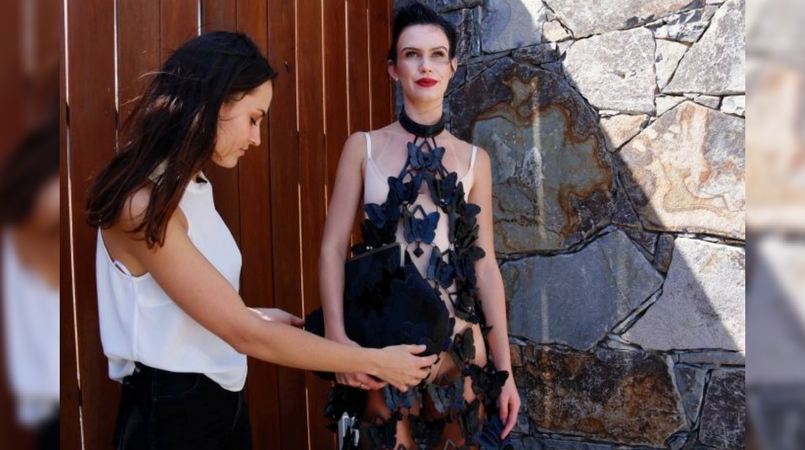
When you think of high fashion, you probably don't think of 3D printing.
But one young Canberran is trying to shake up fashion conventions by taking her digital dreams to the 2017 Vancouver Fashion Week.
Charne Esterhuizen has made an entire dress using 3D printers and hopes to make the industry more sustainable for future generations.
Standing at 175 centimetres tall the dress is made completely out of rubber printed butterflies.
"For one butterfly to be printed it takes five and a half hours ... and the dress consists of 130 to 150 butterflies," the 23-year-old said.
If you are wondering, that equates to about 800 hours of printing.
After dedicating almost six months of her life to the project, Ms Esterhuizen estimates the dress costs about $90,000.
"We've got six dedicated printers running night and day. Like last night I was in here until 3:00am making sure all the printers were working," Michael Slavica from Aussie 3D said.
Ms Esterhuizen is being supported by two printing companies which also believe in the future of printable clothes.
Half of the butterflies were printed at Aussie 3D in Canberra and the other half printed in Poland.
Breaking down 3D fashion misconceptions
The dress is believed to be one of the largest 3D printed fashion projects undertaken in Australia.
Currently 3D printed fashion can be quite heavy and costly, but Ms Esterhuizen believes this will change in time.
Nothing is going to waste in her design.
Normally the offcuts or "raft" left over from each print are thrown away, but Ms Esterhuizen has turned them into a handbag and accessories.
"In the world that we live in today, we see a lot of fast fashion and … through that, there is a lot of waste," she said.
"But you can make these awesome fabrics through 3D printing without harming anyone or any living thing or the environment."
Ms Esterhuizen flies to Canada today ahead of Fashion Week, where it she hoped she breaks down misconceptions about 3D printing.
"3D printing is not just your car parts, it's not just your hearts and lungs. It's fashion. It's clothing," Mr Slavica said
The next step is to create a sustainably printed runway collection and to start experimenting with new sustainable fabrics.
"3D printing just gives you a lot more opportunity," Ms Esterhuizen said.
"If you have a small business like mine, a small label, you can mass manufacture within your home. You can make those jewellery pieces without going overseas."
Ms Esterhuizen believes printing will be the fashion technology for the future because it enables clothing to be custom deigned and printed for customers.
4D printed fashion the next step
But wait, there is more.
With ever-advancing technologies, Mr Slavica said his thoughts were turning to 4D fashions.
"Once we have mastered 3D printing clothing, we will bring in the 4D aspects, which means it is shape changing," he said.
"So when the sunlight hits it, it will change shape, or if it gets an electricity current through it, it can change shape.
"Imagine a dress with flowers all over it, and it's a black dress, and when the model walks out onto the runway and when she gets to the end, it's hit with an electric current and all the flowers open up and you see a coloured dress."
Mr Slavica said the technology is coming.
"This stuff is coming, we just have to perfect the technology. We are right at the beta stage of it," she said.
"We are in that really cool stage where we get to learn, experiment and hopefully we can bring this to life."
Ms Esterhuizen graduated from TAFE only two years ago and started up her own clothing label, MAAK.
She has designed clothes for a number of Australian bands, and Vancouver Fashion Week marks her first international appearance.
